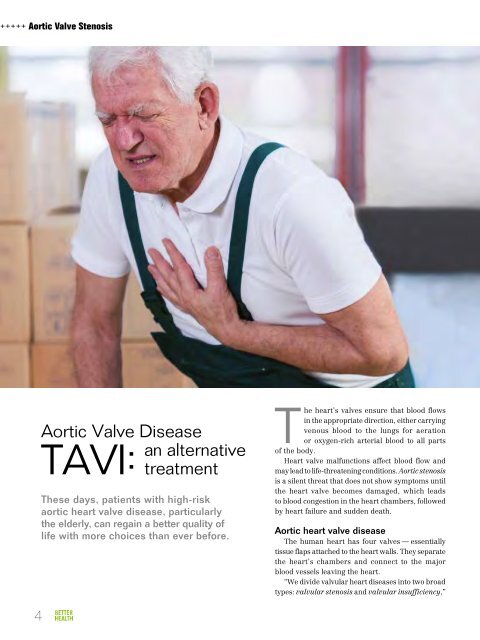Better Health 34 ENG
The magazine for patients and friends of Bumrungrad International Hospital, Thailand. The magazine for patients and friends of Bumrungrad International Hospital, Thailand.
+++++ Aortic Valve Stenosis Aortic Valve Disease an alternative treatment TAVI: These days, patients with high-risk aortic heart valve disease, particularly the elderly, can regain a better quality of life with more choices than ever before. The heart’s valves ensure that blood flows in the appropriate direction, either carrying venous blood to the lungs for aeration or oxygen-rich arterial blood to all parts of the body. Heart valve malfunctions affect blood flow and may lead to life-threatening conditions. Aortic stenosis is a silent threat that does not show symptoms until the heart valve becomes damaged, which leads to blood congestion in the heart chambers, followed by heart failure and sudden death. Aortic heart valve disease The human heart has four valves – essentially tissue flaps attached to the heart walls. They separate the heart’s chambers and connect to the major blood vessels leaving the heart. “We divide valvular heart diseases into two broad types: valvular stenosis and valvular insufficiency,” 4
says Dr. Wattanaphol Phipathananunth, Cardiologist “In valvular stenosis the aortic valve that separates the left ventricle and the body’s main blood delivery artery (aorta), does not fully open, which then restricts blood flow to the aorta.” Dr. Wattanaphol compares the aortic valve to a water valve functioning between a pump and main discharge pipe: when the water valve is closed or partially opened, water cannot flow out freely. Similarly, if doctors can’t fix the heart’s valve, they must replace it. Aortic stenosis has three levels of severity: mild, moderate, and severe. For severe stenosis, the valve is barely open, requiring valvular replacement. Untreated, valvular stenosis could result in death within two to five years after diagnosis. Causes and symptoms Aortic stenosis commonly afflicts the elderly during the body’s natural degeneration. The aortic valve calcifies, which causes it to thicken and narrow. A hallmark symptom is fatigue and exhaustion from everyday activities. Some patients may faint, have tight chest pains, chest oppression, and pulmonary edema making them unable to lay flat. “Patients come to us with general heart disease symptoms of fatigue and exhaustion, but we are unable to pinpoint the specific problem without a detailed diagnosis,” says Dr. Wattanaphol. Diagnosis Diagnosis requires assessing the patient’s medical history, a general physical examination, and specific cardiac examination (usually an electrocardiogram (EKG) and an echocardiogram) to evaluate the level of valvular stenosis. For levels one or two, a valvular replacement is not required. But in severe aortic stenosis, the physician will consider valvular replacement for treatment. Treatment methods There are two treatment methods for an aortic stenosis. “ If the medical team considers open heart surgery too risky, we recommend TAVI to reduce complications” Dr. Wattanaphol Phipathananunth 5
- Page 3: Associate Professor Dr. Somsak Chao
- Page 8 and 9: +++++ Special Scoop Thai Hospital,
- Page 10: +++++ The Case Netipong “James”
- Page 14: +++++ Sports Medicine Preparing you
- Page 17 and 18: p17 Ad Blackmores
- Page 19 and 20: Official Account :
- Page 21 and 22: Dr. Verapan Kuansongtham, Surgeon s
- Page 23 and 24: + Increase dietary fiber by eating
- Page 26: +++++ Health Briefs Obesity and typ
- Page 30: +++++ Bumrungrad News Bumrungrad In
+++++ Aortic Valve Stenosis<br />
Aortic Valve Disease<br />
an alternative<br />
treatment<br />
TAVI:<br />
These days, patients with high-risk<br />
aortic heart valve disease, particularly<br />
the elderly, can regain a better quality of<br />
life with more choices than ever before.<br />
The heart’s valves ensure that blood flows<br />
in the appropriate direction, either carrying<br />
venous blood to the lungs for aeration<br />
or oxygen-rich arterial blood to all parts<br />
of the body.<br />
Heart valve malfunctions affect blood flow and<br />
may lead to life-threatening conditions. Aortic stenosis<br />
is a silent threat that does not show symptoms until<br />
the heart valve becomes damaged, which leads<br />
to blood congestion in the heart chambers, followed<br />
by heart failure and sudden death.<br />
Aortic heart valve disease<br />
The human heart has four valves – essentially<br />
tissue flaps attached to the heart walls. They separate<br />
the heart’s chambers and connect to the major<br />
blood vessels leaving the heart.<br />
“We divide valvular heart diseases into two broad<br />
types: valvular stenosis and valvular insufficiency,”<br />
4



